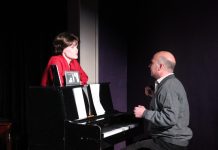By Bill Kamberger
On September 30, 1975, twenty years to the day after the car crash that took the life of movie legend James Dean, six of his female fans gather at a convenience store in a dilapidated and drought-choked Texas town near where he shot his final film, Giant. Such is the setup for Ed Graczyk’s most famous play, which became an all-star movie directed by Robert Altman in 1982, and which is now being revived by Cockpit in Court Summer Theatre.

The play itself is a bit of a five-and-dime store peddling souvenirs of better theatrical days. Its ponderous title, which is also the first line of the script, recalls a similar refrain and situation in Come Back, Little Sheba. Pauline Kael, in her review of the film version, noted the similarity between the fan club’s hopelessly romantic president, Mona (played here by Regina Rose), and A Streetcar Named Desire‘s Blanche DuBois, as well as between the reunion’s mystery guest, Joanne (Laura Malkus at Cockpit), and Hickey, the tortured soul who shatters his old buddies’ illusions in The Iceman Cometh.
But though its components may be recycled, the play’s structure is unique. Not only do scenes set in 1975 frequently share the stage with flashbacks to 1955, but the two eras often intermingle, with a question asked by a character in ’55 sometimes being answered by a character in ’75 and vice versa.
Altman used see-through mirrors to delineate the past from the present, but Cockpit’s director, Linda Chambers, dispenses with such visual aids, trusting we’ll be able to sort out who’s when. Her striking yet fluid in-the-round staging makes that remarkably easy, even when a single step transports a character across two decades, but it also points out how, for most of these women, eerily little has changed in a generation. Indeed, with one possible exception, they all would prefer to be in the past, rather than just live in it.
No age makeup is used either to distinguish the older versions of the supporting characters from their younger incarnations – just as well, perhaps, given that such makeup was the least convincing element of Giant. But the three principals do have their youthful selves portrayed by younger performers who, though they may not be perfect physical matches, act so uncannily like their elder selves that their shared identities are never in doubt.
What’s more, Chambers takes advantage of every opportunity to have the older characters look back on themselves when young, frequently with regret, and even to have the young look ahead to their own middle age, increasingly often with pride. In the hands of this cast, each of these cross-time connections is pure and poignant theatrical alchemy.
Highest praise goes to the youngsters, especially Sarah Jones (as “Mona Then”) and Katelyn Thayer (as “Sissy Then”), for so vividly embodying both the hope for the future and the seeds of its sorrow. Jennifer Skarzinski’s mature Sissy fulfills that promise best, albeit with a vaguely desperate bravado that barely hides her many kinds of scars. Rose plays the adult Mona as she sees herself – upbeat, compassionate, dutiful – making the climactic revelations all the more shocking. And as Joanne, Malkus is both an angel of vengeance and an all-too-human woman, often saying more with a look than the script conveys in pages of dialogue.
In the role of Juanita, the hostess of the titular store’s soda fountain, Liz Boyer Hunnicutt is often tasked with doling out buckets of exposition along with bottles of Grape Nehi, but she manages to make the former palatable, at least. The brassy but tarnished Stella Mae (Laura Weeldreyer) and the faintly yet irrepressibly glowing Edna Louise (Karen Starliper) form an effectively dysfunctional odd couple. And who could forget Jake Schwartz as a tragically confused teenaged boy from the past whose presence remains hauntingly palpable in the present?
Moe Conn’s set is virtually a character, too, as adorned with both an impressive array of James Dean memorabilia (courtesy of Steve Yeager) and a mishmash of holiday décor, as if to drive home that in this town only a red-letter day on the calendar demarcates one season from another. But the unsung heroine of this production is surely Nicole McClellan Smith, whose costumes testify to her genius for color symbolism.
Note especially her use of red, presumably inspired by Dean’s famous red leather jacket in Rebel Without a Cause. It’s found in the fan club’s windbreakers, of course, but also in the flowers that dot young Mona’s dress, as if heralding a blooming future for her. Sadly, these blossoms appear to have faded from the similar dress the older Mona wears, but when Joanne arrives in fiery red pumps, we sense that the day of reckoning has come.
It’s a day you won’t want to miss, as well as a production you’re likely to remember for another twenty years and beyond.
Running Time: Two hours, with one intermission.
Come Back to the Five and Dime, Jimmy Dean, Jimmy Dean plays through August 5, 2018, at Cockpit in Court, performing on the campus of CCBC Essex – 7201 Rossville Boulevard, in Baltimore, MD. For tickets, call 443-840-2787, or purchase them online.




